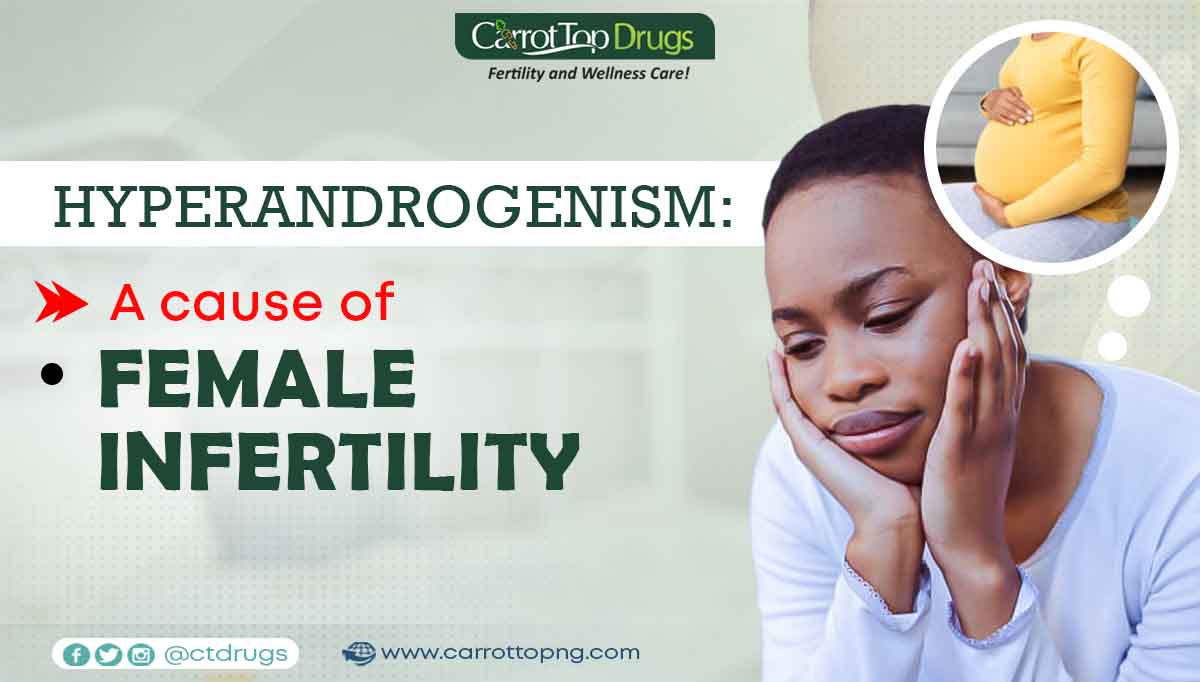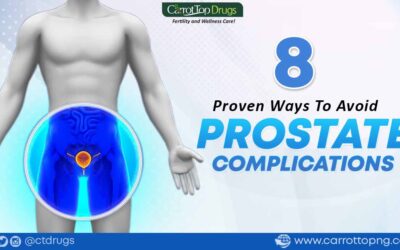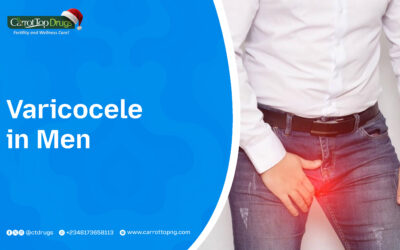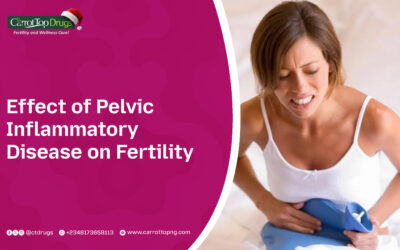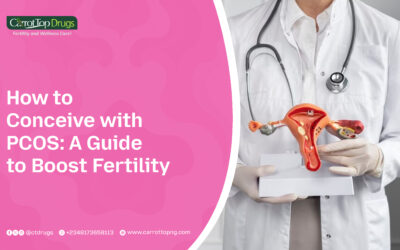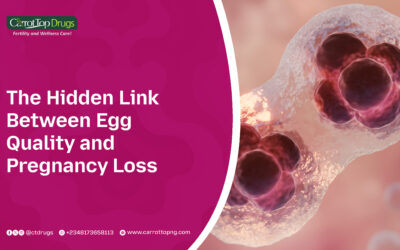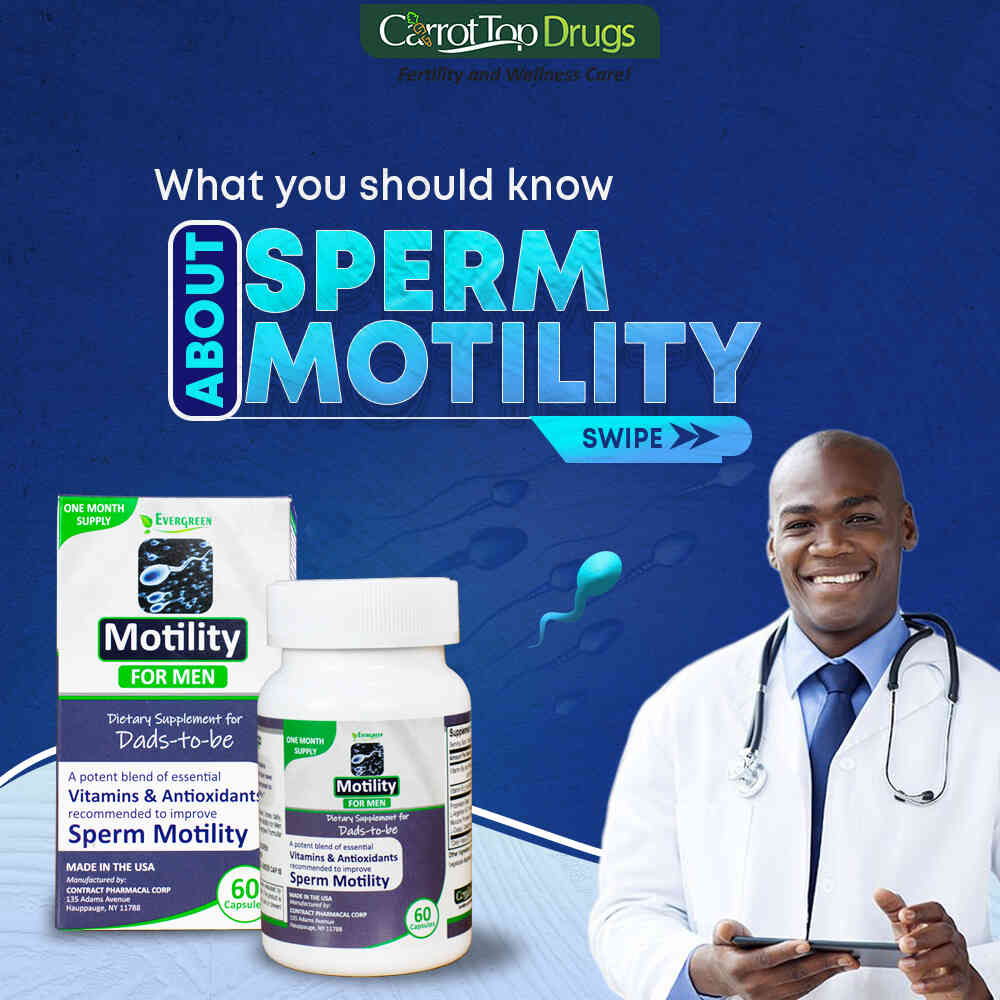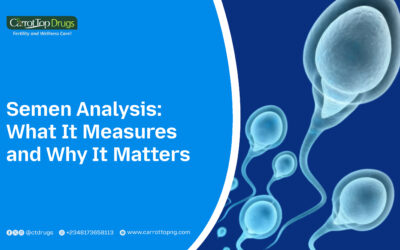Definition of Hyperandrogenism
Hyperandrogenism is a medical condition characterized by excessive levels of androgens, in females. Androgens are male sex hormones, such as testosterone. They are naturally produced in both males and females. But, when their levels become elevated in women, it can lead to various hormonal imbalances and health complications. It is commonly associated with conditions like polycystic ovary syndrome (PCOS) and can significantly impact female reproductive health and fertility.
In this article, we intend to reveal to you how hyperandrogenism can cause female infertility, the causes, and the treatment options available.
Hyperandrogenism and Female Infertility
Hyperandrogenism is a significant cause of female infertility. It is often associated with conditions like polycystic ovary syndrome (PCOS). The excessive levels of androgens disrupt the delicate hormonal balance necessary for normal reproductive function in women. This disruption can lead to a range of fertility issues and difficulties in conceiving.
In women with hyperandrogenism, the excessive production of androgens interferes with the regular menstrual cycle and ovulation. Irregular or absent menstrual periods make it challenging to predict when ovulation will occur. This reduces the chances of successful conception. Furthermore, the presence of cysts on the ovaries, a common characteristic of PCOS, can further hinder the release of mature eggs during ovulation.
Another factor contributing to female infertility in hyperandrogenism is the impact on the quality of the eggs produced. High levels of androgens can affect the development and maturation of eggs. This can lead to poor egg quality. Poor egg quality can make fertilization and implantation less likely. In other words, reducing the chances of a successful pregnancy.
It also affects the uterine environment. This makes it less receptive to embryo implantation. The hormonal imbalance caused by excessive androgens can interfere with the growth and development of the uterine lining. This reduces its ability to support embryo implantation and pregnancy.
Additionally, it can contribute to other underlying conditions that further impair fertility. For example, insulin resistance, a common feature of PCOS, can lead to hormonal imbalances. This makes the regulation of blood sugar levels difficult. These metabolic disturbances can have a negative impact on reproductive function and increase the risk of infertility.
Understanding Hyperandrogenism
Causes of Hyperandrogenism
Hyperandrogenism in women can have various underlying causes. These contribute to hormonal imbalance and excessive production of androgens. Understanding these causes is essential for diagnosing and effectively managing hyperandrogenism.
Here are some common causes associated with this condition:
Polycystic Ovary Syndrome (PCOS)
PCOS is the most common cause of hyperandrogenism in women. It is a complex hormonal disorder characterized by enlarged ovaries with multiple small cysts. Women with PCOS often experience high levels of androgens, irregular menstrual cycles, and other symptoms such as hirsutism (excessive hair growth), acne, and weight gain.
Congenital Adrenal Hyperplasia (CAH)
CAH is a genetic disorder that affects the adrenal glands. Its effect leads to an overproduction of androgens. This condition is present from birth. It can manifest in different forms, with the most common form known as 21-hydroxylase deficiency. CAH can result in hyperandrogenism, virilization (masculinization), and fertility issues in affected women.
Ovarian Tumors
Certain ovarian tumors, such as ovarian stromal tumors and androgen-secreting tumors, can cause hyperandrogenism. These tumors produce excessive amounts of androgens, disrupting the normal hormonal balance and leading to symptoms of hyperandrogenism.
Insulin Resistance
It is a condition characterized by the body’s reduced sensitivity to insulin. Insulin is a hormone that helps regulate blood sugar levels. This condition called Insulin resistance is commonly associated with PCOS and can contribute to hyperandrogenism. It can lead to increased insulin levels, which in turn stimulate the ovaries to produce more androgens.
Idiopathic Hyperandrogenism
In some cases, the exact cause of hyperandrogenism may not be identified. This condition is classified as idiopathic hyperandrogenism. It is a diagnosis of exclusion, meaning other potential causes have been ruled out. However, it still presents with symptoms of excessive androgens, such as hirsutism, acne, and menstrual irregularities.
It is important to note that hyperandrogenism can be influenced by a combination of genetic, environmental, and lifestyle factors. Genetic predisposition, family history, obesity, and certain medications can also contribute to an elevated androgen level in women.
If you suspect you have hyperandrogenism or are experiencing symptoms associated with this condition, it is crucial to consult with a healthcare professional. They can perform a comprehensive evaluation, including medical history, physical examination, and laboratory tests, to determine the underlying cause of hyperandrogenism and recommend appropriate treatment options tailored to your specific needs.
Effects of Hyperandrogenism
Hyperandrogenism in women can have various effects on both the reproductive and metabolic systems. It can lead to a range of symptoms and complications.
Here are some effects commonly associated with hyperandrogenism:
Menstrual Irregularities
Hyperandrogenism can cause disruptions in the menstrual cycle. Women may experience irregular periods, prolonged menstrual bleeding, or even a complete absence of menstruation (amenorrhea). These irregularities occur due to hormonal imbalances affecting the ovaries’ ability to release eggs and maintain a regular menstrual pattern.
Infertility
Hyperandrogenism can significantly impact fertility. The hormonal imbalances and irregular ovulation can make it difficult for women to conceive. The lack of regular ovulation and the presence of cysts on the ovaries can interfere with the release of mature eggs. These reduce the chances of successful fertilization.
Hirsutism
Excessive hair growth, particularly in areas typically associated with male patterns, is a common symptom of hyperandrogenism. This condition is known as hirsutism. It can affect the face, chest, back, and abdomen. The excessive production of androgens stimulates hair follicles to produce thicker, darker, and more abundant hair.
Acne
Hyperandrogenism can contribute to the development of acne in women. The excess androgens stimulate the sebaceous glands in the skin, leading to increased oil production. This, combined with clogged pores, can result in the formation of acne lesions, including pimples, blackheads, and cysts.
Insulin Resistance and Metabolic Syndrome
Hyperandrogenism is often associated with insulin resistance. Insulin resistance can lead to high levels of insulin in the blood, which can further increase androgen production. This interplay between insulin and androgens can contribute to the development of metabolic syndrome, characterized by obesity, high blood pressure, high blood sugar levels, and abnormal lipid profiles.
Psychological Effects
The physical manifestations of excessively high androgen levels, such as hirsutism and acne, can significantly impact a woman’s self-esteem and psychological well-being. Women with hyperandrogenism may experience emotional distress, anxiety, and depression due to the effects on their appearance and the challenges they face in managing the symptoms of the condition.
It is important to note that the effects of hyperandrogenism can vary among individuals and depend on the underlying cause and severity of the condition.
Diagnosis of Hyperandrogenism and Female Infertility
Medical History and Physical Examination
When evaluating an individual with suspected or diagnosed hyperandrogenism, obtaining a detailed medical history and conducting a comprehensive physical examination are crucial steps in understanding the extent and effects of this condition. These assessments provide valuable insights into the individual’s health status, potential underlying causes, and associated symptoms.
During the medical history interview, healthcare providers will inquire about the patient’s reproductive health, menstrual history, and any concerns related to hyperandrogenism. They will explore the regularity of menstrual cycles, the presence of excessive hair growth (hirsutism), acne, scalp hair loss (alopecia), and any difficulties in achieving pregnancy. Additionally, they will inquire about the patient’s medical conditions, family history of hormonal disorders, and use of medications or contraceptives.
The medical history will also include questions about the individual’s overall health, such as their weight and body mass index (BMI), as hyperandrogenism is commonly associated with metabolic disturbances like insulin resistance and obesity. Furthermore, healthcare providers will assess the presence of other signs and symptoms of high androgen levels, such as voice deepening, clitoromegaly (enlarged clitoris), and mood changes.
Following the medical history, a thorough physical examination is conducted to assess the individual’s overall health and identify any physical signs associated with hyperandrogenism. The examination typically includes measuring the patient’s blood pressure, weight, and height to determine their BMI. Healthcare providers will also evaluate the distribution of body fat, looking for signs of central obesity. This is often seen in individuals with hyperandrogenism and insulin resistance.
Skin Examination
Skin examination is an essential part of the physical examination. Hirsutism, characterized by excessive hair growth in a male pattern (such as the face, chest, and back), is commonly associated with hyperandrogenism. Alopecia (hair loss), acne, and skin darkening (acanthosis nigricans) may also be present and can provide valuable clues regarding the severity and potential underlying causes of hyperandrogenism.
Pelvic Examination
Furthermore, a pelvic examination may be performed to assess the size and consistency of the ovaries and to identify any abnormal findings, such as enlarged ovaries or ovarian cysts, which are commonly observed in conditions like polycystic ovary syndrome (PCOS). In these individuals, the ovaries may be enlarged due to the increased production of androgens.
By conducting a thorough medical history and physical examination, healthcare providers can gather critical information to establish a diagnosis and develop an appropriate management plan for individuals with hyperandrogenism. The findings from these assessments, combined with laboratory and imaging results, can guide treatment decisions and help address the underlying causes and associated symptoms of hyperandrogenism effectively.
Hormone Testing and Analysis
Hormone testing and analysis are essential components of the diagnostic process for hyperandrogenism. These tests help healthcare providers assess the levels of various hormones involved in the regulation of the menstrual cycle and the development of male and female characteristics.
Testosterone Test
One of the primary hormones tested in hyperandrogenism is testosterone. The reason is that it is the main androgen responsible for the masculinizing effects. Testosterone levels are typically measured to determine if they are elevated, which is a hallmark of hyperandrogenism. Elevated testosterone levels in females can lead to symptoms such as hirsutism, acne, and menstrual irregularities.
In addition to total testosterone levels, free testosterone levels may also be measured. Free testosterone represents the biologically active fraction of testosterone that is available to exert its effects on tissues. Measuring free testosterone can provide a more accurate assessment of androgen elevation.
Sex hormone-binding globulin (SHBG)
Sex hormone-binding globulin (SHBG) levels are another important hormone parameter analyzed in hyperandrogenism. SHBG binds to testosterone and regulates its availability in the bloodstream. In individuals with elevated androgen levels, SHBG levels may be decreased, resulting in higher levels of free testosterone. Measuring SHBG helps in evaluating the binding capacity of testosterone and understanding the hormonal imbalances present in hyperandrogenism.
FSH and LH
Follicle-stimulating hormone (FSH) and luteinizing hormone (LH) levels are also commonly tested in individuals with hyperandrogenism. These hormones are part of the hypothalamic-pituitary-ovarian (HPO) axis and play a vital role in the regulation of ovarian function and hormone production. Elevated LH levels in relation to FSH levels are often observed in conditions like polycystic ovary syndrome (PCOS), which is closely associated with hyperandrogenism.
Blood Sugar Test
To assess the overall metabolic health and potential insulin resistance commonly seen in hyperandrogenism, fasting glucose and insulin levels may be measured. Insulin resistance is a condition in which the body’s cells become less responsive to the effects of insulin, leading to elevated blood sugar levels. Measuring insulin levels can help identify individuals at risk of developing type 2 diabetes and guide treatment decisions.
Lipid Profile
Furthermore, lipid profile testing may be performed to assess lipid abnormalities commonly associated with hyperandrogenism. This includes measuring levels of total cholesterol, low-density lipoprotein (LDL) cholesterol, high-density lipoprotein (HDL) cholesterol, and triglycerides. Elevated levels of LDL cholesterol and triglycerides, along with reduced HDL cholesterol, are frequently observed in individuals with hyperandrogenism and can contribute to cardiovascular disease risk.
Others
In some cases, additional specialized hormone tests may be performed to evaluate specific aspects of hormonal regulation or to investigate potential underlying causes of hyperandrogenism. These may include tests for adrenal androgens, such as dehydroepiandrosterone sulfate (DHEAS), as well as tests for thyroid function, such as thyroid-stimulating hormone (TSH) and free thyroxine (T4), to rule out thyroid disorders that can mimic hyperandrogenism symptoms.
Interpreting hormone test results requires expertise and consideration of individual patient characteristics. It is essential to compare hormone levels with reference ranges specific to the laboratory conducting the analysis and to interpret the results in the context of the patient’s clinical presentation and symptoms.
These tests help guide diagnosis, monitor treatment effectiveness, and tailor management strategies to address the specific hormone disturbances present in each individual with hyperandrogenism.
Imaging Techniques and Ultrasound
Imaging techniques, particularly ultrasound, play a crucial role in the evaluation and diagnosis of hyperandrogenism. Ultrasound allows healthcare providers to visualize the internal structures of the reproductive system and identify any abnormalities that may be contributing to hormonal imbalances and symptoms associated with hyperandrogenism.
Transabdominal or transvaginal ultrasound is commonly used to assess the ovaries in individuals with hyperandrogenism. This non-invasive imaging technique provides detailed information about the size, shape, and appearance of the ovaries. It allows healthcare providers to identify any structural abnormalities, such as enlarged ovaries or the presence of ovarian cysts.
Polycystic ovary syndrome (PCOS) is a condition closely associated with hyperandrogenism, and ultrasound is particularly useful in its diagnosis. PCOS is characterized by the presence of multiple small cysts (follicles) within the ovaries. These cysts are often seen as enlarged, pearl-like structures on ultrasound. The presence of a certain number of these cysts, typically at least 12, combined with other clinical and biochemical criteria, aids in the diagnosis of PCOS.
Ultrasound can also help assess the thickness and appearance of the endometrium, the inner lining of the uterus. Thickened endometrium may be seen in conditions like endometrial hyperplasia, which can occur due to hormonal imbalances associated with hyperandrogenism. Additionally, ultrasound can help identify any structural abnormalities of the uterus or other pelvic organs contributing to the individual’s symptoms.
In conclusion, imaging techniques, particularly ultrasound, are instrumental in the evaluation and diagnosis of hyperandrogenism.
Treatment Approaches for Hyperandrogenism-Induced Female Infertility
Lifestyle Modifications and Weight Management
Lifestyle modifications and weight management play a crucial role in the management of hyperandrogenism. These approaches aim to address the underlying factors contributing to the condition, such as insulin resistance and obesity and can help restore hormonal balance and improve overall health.
Health Diet
One of the primary lifestyle modifications recommended for individuals with hyperandrogenism is adopting a healthy and balanced diet. This involves consuming various nutrient-rich foods, including fruits, vegetables, whole grains, lean proteins, and healthy fats. A diet high in fiber and low in refined carbohydrates and sugars can help regulate blood sugar levels, reduce insulin resistance, and promote weight management.
Healthy Weight
Weight management is an important aspect of lifestyle modification for individuals with hyperandrogenism, especially those who are overweight or obese. Excess weight can contribute to hormonal imbalances, and insulin resistance, and exacerbate symptoms associated with hyperandrogenism. By achieving and maintaining a healthy weight, individuals can help reduce androgen levels, improve insulin sensitivity, and alleviate symptoms.
Regular Physical Activity
Regular physical activity is also essential for individuals with hyperandrogenism. Engaging in aerobic exercises, such as brisk walking, jogging, cycling, or swimming, can help improve insulin sensitivity, promote weight loss, and enhance overall metabolic health. Strength training exercises, like lifting weights or using resistance bands, can help build muscle mass, increase metabolism, and support weight management efforts.
Stress Management
Stress management techniques, such as meditation, deep breathing exercises, or engaging in hobbies and activities that bring joy, are valuable for individuals with hyperandrogenism. Chronic stress can contribute to hormonal imbalances and worsen symptoms, so finding effective ways to manage stress can have a positive impact on overall well-being.
By implementing lifestyle modifications and focusing on weight management, individuals with hyperandrogenism can positively influence their hormone levels, improve metabolic health, and alleviate symptoms. These modifications are not only beneficial for managing hyperandrogenism but also contribute to overall health and well-being.
Medications for Hyperandrogenism and Ovulation Induction
Medications play a significant role in the management of hyperandrogenism, particularly in addressing hormonal imbalances and promoting ovulation in individuals with reproductive difficulties. Various medications are commonly used to regulate hormone levels, improve menstrual regularity, and enhance fertility outcomes.
Oral Contraceptives
One of the primary classes of medications used in hyperandrogenism is oral contraceptives. These medications contain synthetic hormones, including estrogen and progestin, which help regulate the menstrual cycle and reduce androgen production. Oral contraceptives can effectively manage symptoms associated with hyperandrogenisms, such as hirsutism, acne, and irregular menstrual periods. They also provide reliable contraception and can be beneficial for individuals not seeking pregnancy.
Antiandrogens
Another medication frequently prescribed for hyperandrogenism is antiandrogens. Antiandrogens work by blocking the effects of androgens in the body, helping to reduce the symptoms associated with hyperandrogenism. They can be used alone or in combination with oral contraceptives to achieve better outcomes. Research reveals that Vitamin D can lower the level of androgens in the body. This Vitamin D is found in our EVERGREEN FORMULAR FOR WOMEN.
Ovulation Induction Agents
In cases where individuals with hyperandrogenism are trying to conceive, medications known as ovulation induction agents may be prescribed. These medications stimulate the development and release of eggs from the ovaries, improving the chances of achieving pregnancy. One commonly used ovulation induction agent is clomiphene citrate, which helps regulate the release of follicle-stimulating hormone (FSH) and luteinizing hormone (LH), promoting ovulation. We recommend Ovumine. It is a drug that works.
Drugs That Help Insulin Resistance
For individuals with hyperandrogenism who are also experiencing insulin resistance, medications such as metformin may be prescribed. Metformin helps improve insulin sensitivity, which can in turn reduce androgen production and improve hormonal balance. Vitamin D can also help with insulin resistance. The Vitamin D supplement that we recommend is EVERGREEN FORMULAR FOR WOMEN. By addressing insulin resistance, metformin can also have positive effects on weight management and metabolic health.
It is important to note that the use of medications for hyperandrogenism should be tailored to each individual’s specific needs and goals, and should be prescribed and monitored by a healthcare professional experienced in managing hormonal disorders.
Assisted Reproductive Technologies (ART)
Assisted Reproductive Technologies (ART) are advanced medical procedures that can be considered treatment options for individuals with hyperandrogenism-induced infertility. ART encompasses a range of techniques designed to assist in achieving pregnancy when natural conception is challenging due to various factors, including hormonal imbalances associated with hyperandrogenism.
One commonly used ART procedure is in vitro fertilization (IVF). IVF involves the retrieval of eggs from the ovaries, which are then fertilized with sperm in a laboratory setting. The resulting embryos are cultured for a few days before being transferred into the uterus. IVF bypasses the need for natural ovulation, making it a suitable option for individuals with irregular or absent ovulation due to hyperandrogenism.
While ART can be an effective treatment option, it is not without potential risks and considerations. It is also an expensive procedure. The hyperandrogenic state may impact ovarian response to stimulation, and careful monitoring is essential to prevent complications such as ovarian hyperstimulation syndrome. Additionally, the success rates of ART procedures can vary depending on individual factors and the quality of embryos available for transfer.
Frequently Asked Questions
What is hyperandrogenism?
Hyperandrogenism is a medical condition characterized by excessive levels of androgens, or male hormones, in the body. It primarily affects females and can lead to various symptoms such as irregular menstrual cycles, hirsutism (excessive hair growth), acne, and fertility challenges.
What causes hyperandrogenism?
Hyperandrogenism can have multiple causes, including polycystic ovary syndrome (PCOS), adrenal gland disorders, and certain tumors. PCOS is the most common cause and is characterized by hormonal imbalances affecting the ovaries.
What are the symptoms of hyperandrogenism?
The symptoms of hyperandrogenism can vary but often include irregular menstrual cycles, hirsutism (excessive hair growth on the face, chest, and back), acne, oily skin, weight gain, and infertility. Symptoms can range in severity among individuals.
How is hyperandrogenism diagnosed?
The diagnosis of hyperandrogenism typically involves a combination of medical history evaluation, physical examination, hormone testing, and sometimes imaging techniques such as ultrasound. These help identify hormonal imbalances, underlying conditions, and associated symptoms.
Can hyperandrogenism cause fertility problems?
Yes, hyperandrogenism can impact fertility. Hormonal imbalances, irregular ovulation, and other factors associated with hyperandrogenism can make it more difficult for individuals to conceive naturally. However, there are various treatment options available to improve fertility outcomes.
How is hyperandrogenism treated?
The treatment of hyperandrogenism aims to address the underlying hormonal imbalances and manage the associated symptoms. It may involve lifestyle modifications, weight management, medications (such as oral contraceptives, anti-androgens, or insulin-sensitizing agents), and sometimes assisted reproductive technologies (ART) or surgical interventions.
Can hyperandrogenism be managed naturally?
Lifestyle modifications, including regular exercise, a balanced diet, stress management, and maintaining a healthy weight, can help manage hyperandrogenism to some extent. However, it is important to consult with healthcare professionals for a comprehensive treatment plan tailored to individual needs.
Conclusion
Hyperandrogenism is a condition that affects female fertility. However, in this article, the causes, diagnostic procedures, and treatment options are present. For women struggling with infertility, we recommend our EVERGREEN FORMULAR FOR WOMEN and EVERGREN EGGBOOST. These two supplements have the nutrients to not only boost egg quality but reduce the levels of androgens in women.

